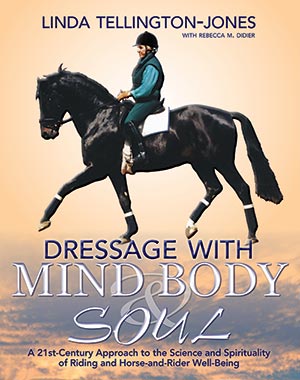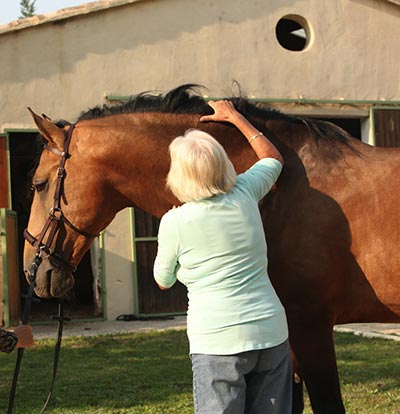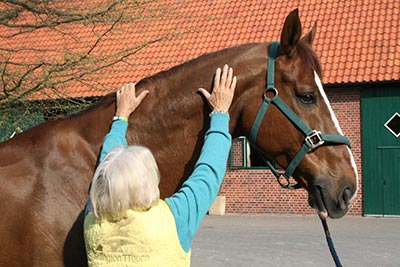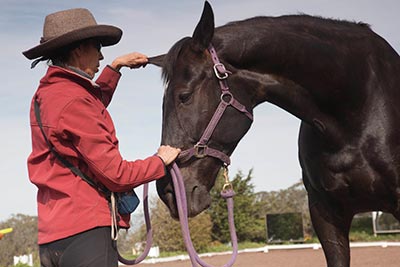
by Linda Tellington-Jones
Renowned animal behaviorist Linda Tellington-Jones shares her recommendation for making time spent grooming a horse a quality experience that builds toward better health and improved performance…for you both.
Step 1 Gather your grooming tools. Final choices will vary depending on your horse’s sensitivity, so to save time, first lay them all out together to allow you the opportunity to test different brushes and find those your horse likes best. With the very sensitive and hyperreactive dressage horse in mind, I like to have a soft rubber mitt or gentle curry (Grooma. products work well), a sheepskin mitt, brushes of different degrees of softness and bristle type, a hairbrush, a bucket of hot water, and some clean towels. In addition, a Tellington Wand can provide a good introduction to the process and help ground your horse before you begin (see Step 4).
Step 2 Take your horse’s pulse and respiration before you begin.
Step 3 The ultimate goal is for your horse to enjoy being groomed enough to stand quietly without being tied or cross-tied. Initially you may need someone to hold him, as this process is most effective if you can use both hands on your horse’s body.
Step 4 Start by stroking your horse with a Wand (or standard white dressage whip—horses seem to respond very differently to white rather than black) all over his body. Stroke firmly to avoid tickling the horse—there should be a slight “flex” to the Wand as you move it against his body. Pay attention to the rhythm and quality of your breathing. Note how your horse is standing during this process: Is he in balance over all four feet? Is he fidgeting? Watch his eyes, ears, and skin—how do they look as the Wand moves?
Step 5 I like to follow the Wand with a sheepskin mitt. Many sensitive horses react to even the softest brush, especially if their grooming experience has been unpleasant in the past. The sheepskin mitt, or another soft and “unexpected” grooming tool, can break this pattern of reaction and the negative behavior that can go along with it, including adrenaline release and poor performance under saddle in the workout ahead. Let the horse look at the mitt. Rest one hand lightly on the halter and do TTouch circles with the mitt on the horse’s face, muzzle, and up around his ears. Watch the horse’s response and monitor your own breathing. With a nervous or headshy horse, it may be best to start at the neck or shoulder after showing him the mitt.



Step 6 Move the mitt slowly over the horse’s body, going with the hair, and make a connection with your horse with your other hand. Watch your horse’s body and expression for signs of concern—a turn of the head, twitch of the ear, stamp of the foot, swish of the tail. Acknowledge these signals and pause, quietly and mindfully. This pause tells the horse you are listening to him and are aware of his uncertainty or discomfort. Note: You do not want to overreact; just acknowledge. After the pause, change something about how you are moving the mitt.
Step 7 Choose a soft brush with a flexible bristle. If your horse is very sensitive or reactive to grooming, place one hand between the brush and your horse’s skin, and move them slowly and gently over the horse’s body. Occasionally let your “support” hand precede the brush, and sometimes, let it follow the brush. Keep the tempo of the strokes and the rhythm of your breathing very slow as you move over the hair. Be aware of your own balance and breathing as you move, as well as your horse’s. Notice how one affects the other. As before, pause and change when your horse reacts negatively or with concern to your brushing—change the pressure or speed of your brush strokes, or the type of brush, and again gauge your horse’s reaction to brushing in the same area. Does the change help? And what does this tell you about where your horse is most sensitive or (possibly) sore? What does this tell you about how your body position and movement impact his mood and stance? How could these affect him in the arena when under saddle?
Step 8 I like to use a human hairbrush on the horse’s mane and tail. Working Hair Slides—from the root of the hair out to the end—into your grooming routine is very relaxing to most horses. The Forelock Slide is one of the most rewarding means of relating to your horse and deepening trust, while at the same time achieving a relaxed, peaceful state in both horse and human.
Step 9 Next, use a damp towel or cloth, soaked in very hot water and wrung out so it is barely wet. Start with the horse’s nostrils, gently clean them, then slowly move the towel up the horse’s face. Proceed to wipe the horse all over his body, ending with the dock and tail, rewetting and wringing out the towel as it cools. I find this leaves the horse clean and relaxed.
Step 10 Especially in the case of a horse who tends to be very reactive to grooming, take your horse’s pulse and respiration again. If they were high when you began, the goal is for them to have settled. If they are high, then your grooming technique—and what you internally and externally bring to the “grooming table,” such as stress or anxiety—is potentially decreasing your horse’s ability to perform his best and connect with you to the degree necessary for artful, joyful performance.
Once your horse learns to enjoy the grooming process, rather than fear or fight against it, you will find that the amount of time you need to groom him will decrease. Rushing the process to begin with, because of your own stress or time constraints, only results in problems in the ring, and thus real wasted time, later. Grooming with Awareness is truly one of the best gifts you can give your horse and yourself.
Note: When you have a groom who regularly works with your horse, I advise working with him or her through this process, at least a few times. It is important for you as your horse’s rider or trainer to experience Grooming with Awareness because it will improve your ability to communicate with your horse in the saddle.
This excerpt from Dressage with Mind, Body & Soul by Linda Tellington-Jones with Rebecca M. Didier is reprinted with permission from Trafalgar Square Books (www.horseandriderbooks.com).
All photos from Dressage with Mind, Body & Soul and used by permission of the publisher.
































